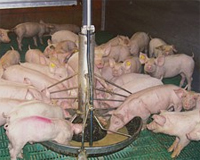RESEARCH: Kansas State estimates antibiotics use in swine

Kansas State University researchers have constructed estimates to accurately reflect available data related to antibiotics use in production practices in the US.
The research team, led by Dr Michael D. Apley, aimed to provide an example of a scientific approach to estimating use of compounds in production animals.
Development of antimicrobial resistance
The study appeared in Foodborne Pathogens and Disease. The researchers wrote that when considering the development of antimicrobial resistance in food animals, comparing gross use estimates of different antimicrobials is of little value due to differences in potencies, duration of activity, relative effect on target and commensal bacteria, and mechanisms of resistance.
They wrote: “However, it may be valuable to understand quantities of different antimicrobials used in different ages of swine and for what applications. Therefore, the objective of this project was to construct an estimate of antimicrobial use through the feed in swine production in the United States.”
“Estimates were based on data from the National Animal Health Monitoring System (NAHMS) Swine 2006 Study and from a 2009 survey of swine-exclusive practitioners. Inputs consisted of number of pigs in a production phase, feed intake per day, dose of the antimicrobial in the feed, and duration of administration.”
“Calculations were performed for a total of 102 combinations of antimicrobials (17 in total), production phases (nursery and grower/finisher), and reasons for use (growth promotion, disease prevention, disease therapy, based on the producer’s intent).”
Farm-level data
Calculations were first conducted on farm-level data, and then extrapolated to the US swine population.
Among the nursery phase estimates, chlortetracycline had the largest estimate of use, followed by oxytetracycline and tilmicosin. In the grower/finisher phase, chlortetracycline also had the largest use estimate, followed by tylosin and oxytetracycline.
As an annual industry estimate for all phases, chlortetracycline had the highest estimated use at 533,973 kg. The second and third highest estimates were tylosin and oxytetracycline with estimated annual uses of 165,803 kg and 154,956 kg, respectively.
Click through to the article itself to view all estimates.
NPPC
The US National Pork Producers Council (NPPC) used the study yesterday to claim opponents of antibiotics use had been ‘fabricating’ evidence by presenting higher figures.
The researchers close off their report stating: “The authors present these estimates for the purpose of informing discussions related to specific antimicrobial uses in swine. Any use estimate should be used with great caution as a basis for policy formation or legislative actions.”
Related websites:
• Kansas State University
• Foodborne Pathogens and Disease
• US National Pork Producers Council (NPPC)











